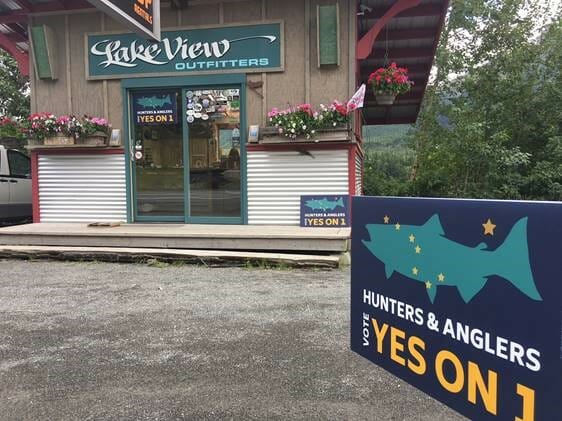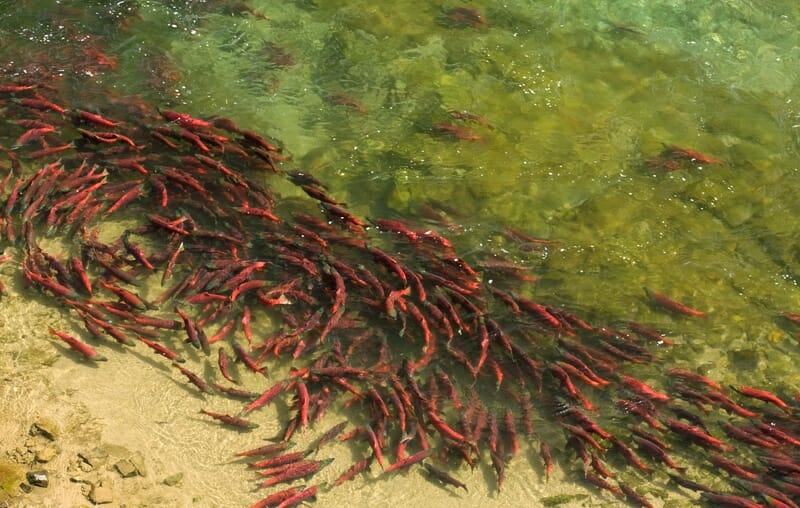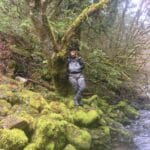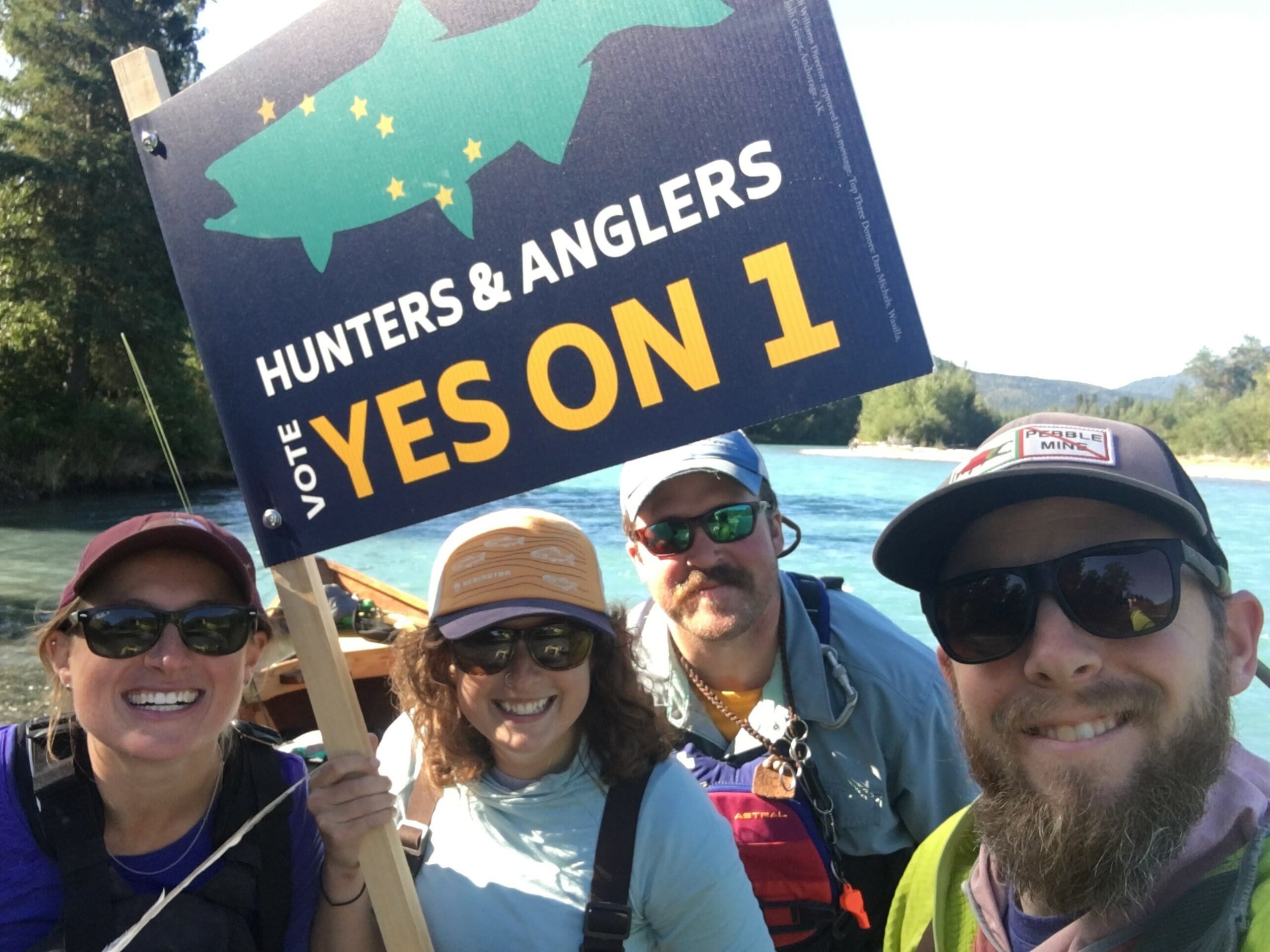Anglers demonstrate support for Ballot Measure 1 while fishing the Kenai River. Photo courtesy of Eric Booton
By Eric Booton
“I came from one of your possible futures: California. Not too long ago, our king salmon runs were bigger than yours, our salmon were bigger than yours, and there still are some,” Hank Shaw, author of the popular blog Hunter Angler Gardener Cook, told a room of Alaskan hunters and anglers in August at a benefit for the Stand for Salmon Campaign.
Hank Shaw does not have the ability to travel through time. He simply has had the experience of living in an area where irresponsible development and habitat loss have primarily driven salmon and steelhead to extinction.
There is a tragic story many Alaskan anglers are unfortunately not familiar with from my experience conducting outreach to anglers for over 5 years now. The story of wild pacific salmon along the United States’ West Coast is surprisingly unknown in Alaska, though it is the alarmingly urgent lens through which Trout Unlimited Alaska and conservation-minded businesses and anglers approach salmon habitat conservation.

Lakeview Outfitters in Cooper Landing, AK demonstrates support. Photo courtesy of Lakeview Outfitters
Alaska’s landscape sustains overwhelmingly healthy runs of wild Pacific salmon with relatively small hatchery influence throughout the massive state. Contrary to common misconceptions, this isn’t due our management or what has been described as a “rigorous permitting process.” Our salmon runs are what they are today because we are a young and growing state that has yet to disturb and destroy critical fish habitat to the extent that Washington, Oregon, and California have. The United States’ West Coast has been plagued with extinct and endangered salmon and steelhead runs, over 400 in total, in part due to mass habitat degradation and loss. These states have since spent billions trying to restore salmon streams and rebuild fish stocks with mixed success all while we Alaskans benefit from our healthy fisheries virtually for free.
Alaska is the last stronghold for wild Pacific salmon that feed our residents and allow Native communities to practice their subsistence culture and traditions. If that moral reason alone isn’t enough to necessitate increased protection of critical salmon habitat in the state, there is a demanding economic obligation as well. Salmon are a major economic driver in Alaska and support 43,000 direct and indirect jobs and contribute over $4.8 billion to our economy every year. These are jobs and income that we can benefit from for generations to come, assuming we manage them responsibly. Under this lens, it’s obvious that responsible management should include carefully and scientifically evaluating projects that will have a large impact on fish habitat.
Alaska will continue to grow. Our future is limitless IF we put limits today on the damage we allow to be done in critical fish habitat. To grow and preserve our fisheries, it is required that we develop responsibly. However, today, short-sighted projects are increasingly proposed in Alaska that compromise the future of our prized salmon streams and instill exactly zero lessons from what we have learned elsewhere. Our fish habitat permitting law intended to protect our salmon from incompatible development, written 60 years ago, is ½ of a page long, leaves over 50 percent of Alaska’s salmon streams unprotected and directs a permit to be given unless the project is found to be “inconsistent with the proper protection of fish and game.” In the law, there is zero definition of what the proper protection means. There is simply not enough in our current law to properly evaluate the impact of the mega projects we currently face, which are of a scale that was unimaginable at the time the law was written.
The proposed Pebble Mine is a clear poster child for mass salmon habitat loss that would be allowed to proceed under the State’s current fish habitat protection law. Pebble’s phase one plan includes a 15-sq mile footprint, almost 100 miles of private roads and over 200 stream crossings, filling over 4,000 acres of wetlands with waste and more. Likewise, the proposed Chuitna Coal Mine, Susitna Dam and Snow River Dam each would have had a massive impact on critical salmon habitat. These projects would easily have received their fish habitat development permit from the Alaska Department of Fish & Game had they entered the permitting process rather than being tabled for economic reasons or immense opposition.

Bristol Bay sockeye pooling. Photo by Ben Knight
If we want salmon around for the future and don’t want to spend billions in restoration, we simply must admit that our permitting process is broken and work to fix it. Luckily, in 2018, we have the best way to move forward. By voting yes on ballot measure 1 and updating the law, we can ensure that salmon habitat is properly evaluated and protected during the permitting process. Ballot Measure 1 is a balanced and scientifically-driven opportunity for Alaskans to improve the current law by defining the proper protection of fish and game through clear and scientific standards (water quality/quantity, fish passage and access to spawning habitat, etc.) that will allow for the responsible development of Alaska’s resources and give Alaskans a seat at the table in that process.
The story of wild salmon in the Lower 48 has been written at this point. The story of wild salmon in Alaska, however, is still being written. Today we have the distinct potential to strengthen for critical salmon habitat under Ballot Measure 1.
Ballot Measure 1 is good for fish, good for business, and good for Alaska. Trout Unlimited supports Ballot Measure 1 and encourages Alaskans to vote “yes” on November 6th. Join the growing community of hunters, anglers and business owners supporting Ballot Measure 1 and commit to vote here.
Eric Booton is the Alaska Sportsman’s Organizer. He lives and works in Anchorage.
Paid for By Trout Unlimited Alaska, Anchorage, AK. Nelli Williams Director, approved this message. Top Three Donors are Dan Michels, Wasilla, AK; Alaska Fishing Unlimited, Port Alsworth, AK; and Josh Grieser, Anchorage, AK



